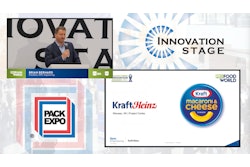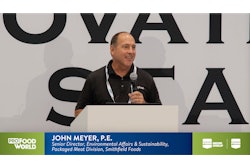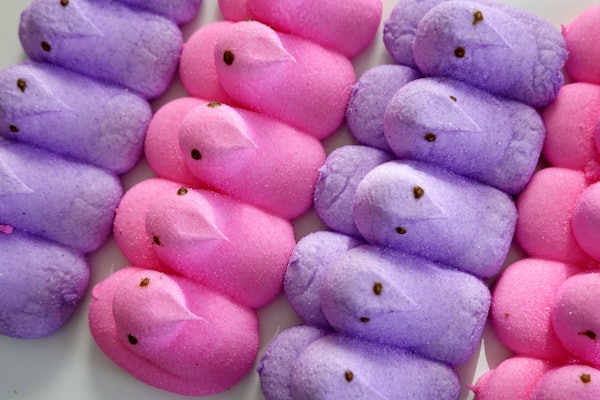Are you a manufacturer who's completed an outstanding food or beverage processing or packaging innovation project? Apply to the Manufacturing Innovation Awards to be honored both in print and at PACK EXPO International 2022.
Listen to the story here:
 | Read the transcript below: |
Joyce Fassl: Good afternoon, everybody. Welcome to the ProFood World 2021 Manufacturing Innovation Awards. My name is Joyce Fassl, and I'm the Senior Executive Editor at ProFood World Magazine. So just a little bit about ProFood World before we get started.
We're a part of PMMI Media Group. And we're published six times a year, and we're distributed to more than 30,000 industry professionals. In addition, you might have seen this around the show the processing zone showcase, we also produce that. You can also find our daily news updates online, and each week we have a new newsletter called Joyce's Voice. So you can sign up for that too, itusually comes out Monday or Tuesday of each week.
So at ProFood World, our content focuses on the food and beverage manufacturing industry, innovation, and technology. So before we begin our award, before we invite our award winners up to the stage, just wanted to go over some background on how the awards are chosen. So eligible projects each year can be major plant expansions, major renovations, Greenfield plants, brownfield major line expansions, incorporating groundbreaking technology, new to the industry technology, major plant automation upgrades, or food safety upgrades. We also focus on sustainability when we're looking at the awards and then overall plant efficiency upgrades. Now, the judging criteria is based on high level of technology advancement and processing and packaging machinery. We also look at the level of automation software and controls. I mentioned new to the industry use of technology, so we look for major efficiencies and cost savings. How line changeovers are done, flexible manufacturing, food safety, sustainability, maintenance improvements, and we also look at the labor factor—does somebody have an exceptional worker recruitment and engagement program. We look at tools like OEE and lean manufacturing. And also, you know, some of the protocols that were implemented during the COVID-19 pandemic. So our Entries are due usually mid January each year and for next year's awards we're going to be they're going to be due January 17 2022. And for the 2022 Awards, the projects must be completed between June of 2020 and December of 2021, then they can send in their entries in January. So entries should be based on a single plant location. For more information about how to enter the awards, we have a pretty URL. It's PFWgo.to/MIA.
Well, here are our winners! We have MWC Kraft Heinz and CTI foods. So congratulations to everybody here. And I'll just give a little overview of each plant. So MWC is recognized for its new 400,000 square foot state of the art facility in St Johns, Michigan, which processes about 25% of the state's milk production. So intellectual property proven equipment and technology, operational readiness. A seasoned workforce and the perfect partnerships provided a winning combination to launch MWC's greenfield dairy facility. The Kraft Heinz project involved its iconic macaroni and cheese product, and they expanded and modernized their Wausau, Wisconsin facility. And this project includes building upgrades, new liquid and powder handling systems, and a complex cleaning place system to fulfill production needs, providing a production increase of more than 40%. CTI foods serves the restaurant and food industry with protein soups, sauces, and dressings. In order to automate its labor intensive filled taco line, special end of arm tooling was designed to perform dual picks of the tacos and orient take them into trays, and this upgrade tremendously improve the production rate to 960 tacos per minute across four packaging cells. So for our first presentation, I'd like to welcome George Chapelle, he's vice president of dairy operations for Glanbia Nutritionals, to tell us about his award winning facility.
Chappell George: It's a pleasure to be with you to hear today. I get to be the mouthpiece for a lot of work. So I'm going to share just a little bit initially to talk to you about who is MWC. And anybody who has been involved in a greenfield site knows, this isn't a team of one, it takes a takes a lot of effort all the way across the entire supply chain, from commercial to marketing to strategy. And it takes a lot of work on a day to day effort to get the work done with the with the contractors to build the plant and get it started.
So I'm gonna start off and talk to you a little bit about who is MWC because we'll throw out a bunch of different names and it'll help hopefully help tie it all together. MWC is a joint venture that consists of basically two partners. One of them is Glanbia who is a PLC based out of Kilkenny, Ireland, and the other partner is what we call the "milk member" and that consists of DFA and Select Milk.
Now both partners have very distinct roles and responsibilities and it's why it works. It creates a healthy tension across the entire supply chain from milk on the farm to product to the consumer. Obviously with this JV it gives the milk member an opportunity to have a secure place to place their milk. And Glanbia has the opportunity then, once the milk arrives in its four walls, to process the milk and produce products—cheese and whey products. That then gets sold both within the US and globally.
Here's a little bit about Glanbia Nutritionals—Glanbia has three distinct divisions within. The PLC Glanbia Nutritionals is the division where the PLCs are operated out of and you can see Glanbia Nutritionals has a strong footprint across the entire US—both in dairy manufacturing, and what we call specialties. Specialties is anything not dairy operation related, such as vitamins, minerals, powder blending, and even recently an acquisition that we were going to get into puffs. This gives more of a global footprint footprint of where Glanbia does business including it sales offices. And you can see we do have a global footprint. We play heavily in the US. We are number one suppliers of American style cheese in the US. Everybody always asks what do you do? Well, I'm part of the largest cheese manufacturer that you've never heard of, because all the business that we do is B2B. So all of the products that we make go and end up being an ingredient for somebody else or someone else's package.
So MWC—a couple of quick stats—it is almost a half a billion dollar investment. On 120 acre greenfield site, we have roughly 250 employees. The main products that we produce are American style cheese and high value add whey protein concentrates both in WPC and WPI whey protein isolate. Everybody knows, when you start a greenfield site, you better be very clear about what it is that you want at the end. So while you're you're building that you can be clear that you're you know, you're on the right path to get get there. So we came in with some pretty good knowledge having had a greenfield site in Clovis, New Mexico called Southwest Cheese. And MWC really is almost a carbon copy of what is what was originally developed there. So the facility runs 8 million pounds of milk a day, which is about 25% of all of the milk produced in the state of Michigan and Michigan is about the sixth or seventh largest milk producing state in the United States. So it's a fair amount of milk. Most of that milk prior to this plant being built was being shipped outside of the state. So it makes good sense for the milk producers that we're there. I'm gonna let Dave kind of go into some more of the detail here around what it took to build the plant but some of the details we'd make most of our cheese products are in 40 pound blocks, and 640 pound blocks. 640 pound block looks like a small refrigerator. And all of our products then end up going to another company who's going to slice and dice it, chunk it, and put it into another package. Our whey protein powders end up in everything from bodybuilding products to anything that you want to supplement for whey protein products.
This is kind of a top down view of the campus and you can see MWC on the kinda upper left hand corner. Proliant is one of our partners that we went into this with. One of the byproducts of cheese and whey protein is a product that we call permeate to effectively lactose sugar and some minerals, and proliant takes all that and it's about 2200 pounds permeate powder as produced per week through proliance. So they were building their facility simultaneous to the time that we were building our facility. And we share a lot of similar utilities across the bridge through Steam, and a pipeline directly from our facility over to theirs. The plant is so large, we had to break it up into different sections.
As I mentioned Shambaugh & Sons were the general contractor and fantastic partner throughout of this throughout this project. When we started the project, we we went through an RFP process just to request for for bids. And it was the first time that we had done a project of this size with S&S and we were very pleased with the outcome. They brought a lot to the table, such as their 3D design and engineering that allowed us to be more efficient in making changes and making sure that we got down right into the detail, so we knew exactly where it needed to be. And even down to the 16th of an inch makes a difference on this size of a project. Some of the other very notable contractors who are are very well known throughout the food industry are CFR, GEA, Tetrapak, and Mill-Mac are key parts of this project. Each one of them when we did the bid, ended up with a section of the plant—the plant was so large that we didn't feel comfortable having just one processor take on the whole lot.
So we touched on some of the milk metrics. And here's a little bit more on the product volumes, and a few pictures to kind of give you the scale and the magnitude of this facility. It is one of the largest cheese manufacturing facilities in the United States. We have one other larger in Clovis, New Mexico that process about 14 million pounds of milk a day that's larger than this facility. When we design this plant, as I just mentioned, it was kind of a carbon copy of that facility. And we designed this plant with expansion in mind. So Dave is going to come up again, huge thanks to Dave.
David North: Good afternoon. As George says, I'm David North, and I'm the guy retiring in three days time. So what I'm gonna do is tell you some of the numbers from the construction. We mentioned it was formed in 29,000 square feet. We did something like 4.5 miles of site utilities. So it's predominately a tilt up. So precast concrete tilt up 2100 of those parts, brought in sequenced in again through Shambaugh and their teams, some nice touches that when they made the precast, they cast a lot of the utilities within those precast. So we don't see them and walls, we get a very, very clean look to the inside of the factory. It's a nice way of doing it. And likewise with embeds. So we've got like something like 3100 embeds stencil embeds built into those pre-casts. So that then we bring in the pipe racking, we just bring it in, we lift it up to the ceiling, and it just drops in really sweet. So it makes for a very good clean construction.
Some of the utility metrics. So something like 21 miles of utility piping, it's all done using the CAD system that Joe was touching on earlier. So again, you can see upfront what it's like and how it all goes together. So 60,000 pounds of ammonia. So that was the one that we had to get a heads round and make sure we get that right because we need refrigeration. But there are a real energy burn if you don't get it right. So he put a really good, highly efficient ammonia plant from within the main building. And then some electrics, so eleven 3000 amp services. So they're all distributed around the site so that we can keep the copper runs as short as we can, again, to keep more efficient. I think it's the one that gets me as they're like, you know, 2500 light fixtures, again, energy efficient, because, again, when you turn on 2500 light bulbs, it burns electricity. So again, all the time, we're trying to figure out how we, how we keep it all sort of under control and a very effective and efficient so part of packaging.
So we basically, as Joel says, we make a WPC and a WPI product. So we haven't got too many variations, but we're trying to get it done in a tighter form as possible. So we're going to give it out in 20 kg bags or in 1000 kg totes. We were manufacturing 24 hours a day, but we like to package just for 12 hours a day because it makes it more effective and easier for labor force.
We touched on sustainability earlier, but wastewater has always been a big issue and we took a slightly different approach to how we did it. So we split the stream from the high strength COD to low strength and we did that through either an anaerobic or aerobic digestive system so it allows us not to be over processing the clear water. It allows us with a very small footprint to have a very effective very efficient wastewater treatment plant. Michigan, like everyone else, has very tight tolerances when you're discharging so we can't have any sort of mishaps. It's a very nice system.
Likewise with heat from the pasteurizer—it's about heat recovery. So we'll take the heat from our whey pasturizers and transfer that across to our milk pasturizers and vice versa so there's no no wasted heat in any part of the process. We touched on the motors we've got like 1500 motors of which 90% of those are highly efficient and 9% of those are on VFDs so we literally we can tune every single motor to be just the right amount of power that we need or the speed that we need. So again, no wasted energy.
Joyce Fassl: Gentlemen, I'd like to congratulate you on a fantastic project. Thank you for having me out to the plant. Dan, I like to congratulate you on a great project with MWC. Congratulations to all the employees of Shambaugh and all the employees of MWC on our manufacturing innovation award winner. Thank you gentlemen.





















